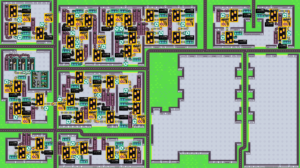So, Munch’s Oddysee has these vending machines dispensing power-ups in the form of soft drinks. Some can be used by both player characters, some are exclusive to Munch. A drink called “Expresso”, for example, makes either character run faster, while “Zap!” lets Munch attack nearby enemies with electrical arcs from his cranial implant. Health can be restored with cans of SoBe energy drink, from vending machines with the SoBe logo with the two lizards.
I’m informed that this isn’t the case in all version of the game. Apparently there’s a HD remake for Playstation 3 and Vita that uses a made-up “Health Up!” brand name instead. But in the version I’m playing, it’s SoBe, except for one Health Up machine I’ve seen. I don’t know what the deal is with that.
This is far from the first or worst instance of egregious product placement I’ve seen in games. The example I always think of is Lemmings 3D (aka 3D Lemmings), which stuck Jelly Belly logos all over the place, and even made a huge jar of jelly beans into a major part of one level’s geometry. To this day, whenever I see Jelly Bellies, I think of Lemmings, which is presumably the opposite of what was intended. I also think of the obscure 2002 action-adventure Darkened Skye, which was actually designed from the ground up as an advergame for Skittles, even basing its content on then-current Skittle commercials and including a Skittle-based magic system. The truly remarkable thing about Darkened Skye, however, was that, unlike most games based on junk food, it tried to hide it. The packaging mentioned Skittles only in the small print on the back, and you could play it for a couple of hours before encountering any Skittle content. Today, it’s remembered for nothing else.
And that’s why I feel the way I do about product placement of this sort: that it’s the sign of a game that’s lost its way as art. It’s letting money dictate content. Well, okay, that’s going to be the case regardless. Budgets are limited, and studios need to make games that will sell. But this is letting money dictate content in an obvious and intrusive way, and I have to wonder if the increased brand awareness is enough to outweigh the resentment it engenders. I’ve heard tell that gun manufacturers pay handsomely to get their wares included in the latest military shooters, and that’s creepy, but in a way, it doesn’t seem as bad to me, because at least guns are relevant to a shooter. They belong there in a way that Earth beverages don’t belong in the Oddworld.
The Oddworld setting even gives the whole deal some additional ironies, starting with the way that the whole story is one of struggle against capitalist excess. Putting ads in games is, when you think about it, totally something Glukkons would do. But also, beverage manufacturers in particular were the main bad guys in the previous game. Now, understand that there’s a completely deliberate irony of Abe and the Mudokons using and even relying on the products of their oppressors. Abe’s Oddysee makes it clear that Abe has eaten and enjoyed the Scrab Cakes and Paramite Pies made from his people’s sacred animals, and Abe’s Exoddus has him drinking a Glukkon-made beverage from vending machines as part of solving puzzles, much like he does here in Munch’s Oddysee. But the premise of Abe’s Exoddus is that the Glukkons are using the addictiveness of that very same beverage to re-enslave the Mudokons, and late in the game there’s a revelation about how it’s made that I won’t spoil. As such, I have to wonder if SoBe really thought this through. This is the sort of thing that advertisers tend to be sticklers about. The story of Munch’s Oddysee itself doesn’t seem to contain anything so outright negative about its soft drinks, but the game does make all the cutscenes from Abe’s Exoddus available from its main menu as a recap of the story so far. Considering how ham-handed the product placement is in the first place, I suppose it’s just a matter of nobody involved knowing what they’re doing.
 Comments(0)
Comments(0)